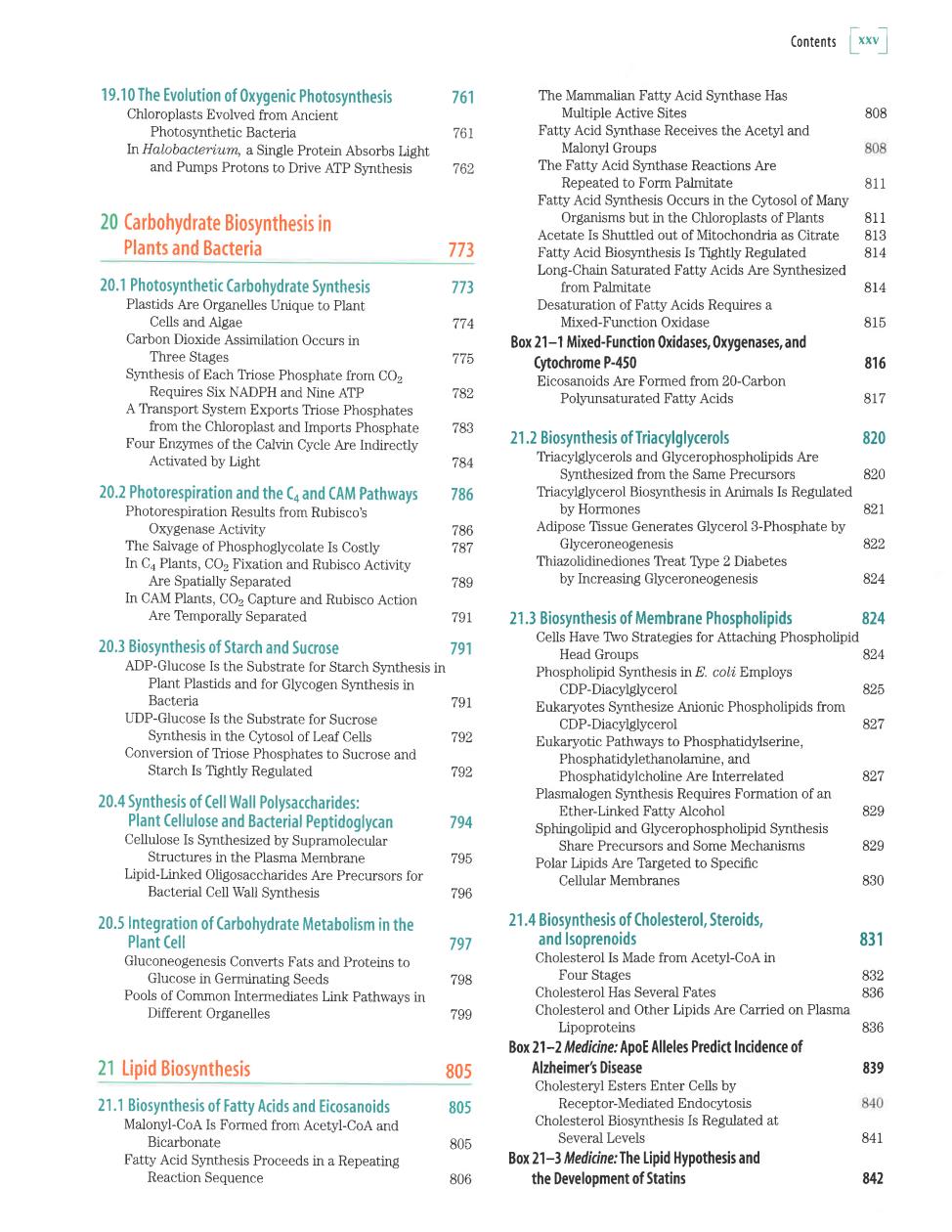
Contents19.10 The Evolution of Oxygenic Photosynthesis761The Mammalian Fatty Acid Synthase Has808Chloroplasts Evolved fromAncientMultiple Active SitesFatty Acid Synthase Receives the Acetyl andPhotosynthetic Bacteria761808Malonyl GroupsIn Halobacterium,a Single Protein Absorbs LightThe Fatty Acid Synthase Reactions Areand Pumps Protons toDrive ATP Synthesis762811RepeatedtoFormPalmitateFattyAcid Synthesis Occurs in theCytosol of ManyOrganisms but in the Chloroplasts of Plants81120 Carbohydrate Biosynthesis in813Acetate Is Shuttled out of Mitochondria as CitratePlants and Bacteria773FattyAcid Biosynthesis Is Tightly Regulated814Long-Chain Saturated Fatty Acids Are Synthesized20.1 Photosynthetic Carbohydrate Synthesis773fromPalmitate814Plastids Are Organelles Unique to PlantDesaturation of Fatty Acids Requires aCells and Aigae774815Mixed-FunctionOxidaseCarbon Dioxide Assimilation Occurs inBox211Mixed-FunctionOxidases,Oxygenases,andThree Stages775CytochromeP-450816Synthesisof EachTriosePhosphatefromCOzEicosanoidsAreFormedfrom20-CarbonRequires Six NADPH and Nine ATP782817Polyunsaturated Fatty AcidsATransport System Exports TriosePhosphatesfromtheChloroplastandImportsPhosphate78382021.2 Biosynthesis ofTriacylglycerolsFour Enzymes of theCalvin CycleAre IndirectlyTriacylglycerols and Glycerophospholipids Are784Activated by Light820Synthesized from the Same PrecursorsTriacylglycerol Biosynthesis in Animals Is Regulated20.2Photorespiration and theCy and CAM Pathways786821byHormonesPhotorespiration ResultsfromRubisco'sAdipose Tissue Generates Glycerol 3-Phosphate by786Oxygenase Activity822GlyceroneogenesisThe Salvage of Phosphoglycolate Is Costly787Thiazolidinediones Treat Type 2DiabetesIn Cy Plants,COFixation and Rubisco Activity824byIncreasing Glyceroneogenesis789AreSpatiallySeparatedIn CAM Plants,COg Captureand Rubisco ActionAreTemporally Separated79182421.3Biosynthesisof MembranePhospholipidsCells Have Two Strategies for Attaching Phospholipid20.3Biosynthesis of Starch and Sucrose791Head Groups824ADP-Glucose Is the Substratefor Starch Synthesis inPhospholipid Synthesis in E.coli ErmploysPlant Plastids and for Glycogen Synthesis in825CDP-DiacylglycerolBacteria791Eukaryotes Synthesize Anionic Phospholipids fromUDP-Glucose Is the Substratefor Sucrose827CDP-DiacylglycerolSynthesis in the Cytosol of Leaf Cells792EukaryoticPathwaystoPhosphatidylserineConversion of TriosePhosphates to SucroseandPhosphatidylethanolamine,andStarch Is Tightly Regulated792827Phosphatidylcholine Are InterrelatedPlasmalogen Synthesis RequiresFormation ofan20.4SynthesisofCellWall Polysaccharides829Ether-Linked FattyAlcohol794Plant Cellulose and Bacterial PeptidoglycanSphingolipid and Glycerophospholipid SynthesisCellulose Is Synthesized by Supramolecular829Share Precursors and Some MechanismsStructures in the Plasma Membrane795Polar Lipids Are Targeted to SpecificLipid-Linked Oligosaccharides Are Precursors for830Cellular Membranes796Bacterial Cell Wall Synthesis21.4Biosynthesisof Cholesterol,Steroids20.5 Integration of Carbohydrate Metabolism inthe831and IsoprenoidsPlantCell797Cholesterol Is Made from Acetyl-CoA inGluconeogenesis Converts Fats and Proteins to832Four Stages798Glucose in Germinating SeedsCholesterol Has Several Fates836Pools of Common Intermediates Link Pathways inCholesterol and OtherLipids Are Carried on PlasmaDifferent Organelles799836LipoproteinsBox 21-2 Medicine:ApoE Alleles Predict Incidenceof83921 Lipid BiosynthesisAlzheimer's Disease805Cholesteryl Esters Enter Cells by840Receptor-Mediated Endocytosis21.1 Biosynthesis of Fatty Acids and Eicosanoids805Cholesterol Biosynthesis Is Regulated atMalonyl-CoAIsFormedfrom Acetyl-CoAand841Several LevelsBicarbonate805Box21-3Medicine:The Lipid Hypothesis andFatty Acid Synthesis Proceeds in a Repeating842Reaction Sequence806the Development of Statins
1 9.1 0 The Evolution of 0xygenic Photosynthesis Chloroplasts Evolved from Ancient Photosynthetic Bacteria In Halobacteri,um, aSingle Protein Absorbs Light and Pumps Protons to Drive ATP S;,rrthesis 20 Carbohydrate Biosynthesis in Plants and Bacteria 20.1 Photosynthetic Carbohydrate Synthesis 773 Plastids Are Organelles Unique to Plant Cells and Algae 774 Carbon Dioxide Assimilation Occurs in Three Stages TTb Sy'nthesis of Each Ttiose Phosphate from CO2 Requires Six NADPH and Nine ATP TB2 A Tlansport System Exports T?iose Phosphates from the Chloroplast and Imports Phosphate 783 Four Enz)rmes of the Calvin Cycle Are Indirectly Activated by Light 784 20.2 Photorespiration and the Coand (AM Pathways 786 Photorespiration Resuits from Rubisco's Oxygenase Activity 786 The Salvage ofPhosphoglycolate Is Costly T8T In Ca Plants, CO2 Fixation and Rubisco Activity Are Spatially Separated T8g In CAM Plants, CO2 Capture and Rubisco Action Are Temporally Separated TgI 20.3 Biosynthesis of Starch and Sucrose 791 ADP-Glucose Is the Substrate for Starch Slnthesis in Plant Plastids and for Glycogen Synthesis in Bacteria TgI UDP-Glucose Is the Substrate for Sucrose Synthesis h the Cytosol of Leaf Cells Tg2 Conversion of Tfiose Phosphates to Sucrose and Starch Is Tightly Regulated Tgz 20.4 Synthesis of Cell Wall Polysaccharides: Plant Cellulose and Bacterial Peptidoglyca n 794 Cellulose Is Synthesized by Supramolecular Structures in the Plasma Membrane Zgb Lipid-Linked Oligosaccharides Are Precursors for Bacterial Cell Wall S1'nthesis T96 20.5 lntegration of Carbohydrate Metabolismn the Plant (ell 797 Gluconeogenesis Converts Fats and Proteins to Glucose in Germinating Seeds 798 Pools of Common Intermediates Link Pathways h Different Organelles 799 21 Lipid Biosynthesis 21.1 Biosynthesis of Fatty Acids and Eicosanoids Malonyl-CoA Is Formed from Acetyl-CoA and Bicarbonate Fatty Acid S5.nthesis Proceeds in a Repeating Reaction Sequence 808 811 761 IOI 762 contents [-l The Mammalian Fatty Acid Synthase Has Multiple Active Sites Fatty Acid Synthase Receives the Acetyl and Malonyl Groups The Fatty Acid Slnthase Reactions Are Repeated to Form Palmitate Fatty Acid Slnthesis Occurs in the Cytosol of Many Organisms but ir the Chloroplasts of Plants 811 Acetate Is Shuttled out of Mitochondria as Citrate 813 Fatty Acid Biosynthesis Is Tightly Regulated 8I4 Long-Chain Saturated Fatty Acids Are S5,'nthesized from Palmitate 814 Desaturation of Fatty Acids Requires a Mixed-Function Oxidase 815 Box 21 -1 Mixed-Function Oxidases, 0xygenases, and Cytochrome P-450 816 Eicosanoids Are Formed from 20-Carbon Pollrrnsaturated FattyAcids 817 21.2 Biosynthesis of Triacylglycerols 820 Tliacylglycerols and Glycerophospholipids Are Synthesized from the Same Precursors 820 Ttiacylglycerol Biosy'nthesis in Animals Is ReguJated by Hormones 821 Adipose Tissue Generates Glycerol 3-Phosphate by Glyceroneogenesis 822 Thiazolidinediones Tfeat Tlpe 2 Diabetes by Increasing Glyceroneogenesis 824 21.3 Biosynthesis of Membrane Phospholipids 824 Cells Have TWo Strategies for Attaching Phospholipid Head Groups 824 Phospholipid Synthesis nE. coli, Employs CDP-Diacylglycerol 825 Eukaryotes Synthesize Anionic Phospholipids from CDP-Diacylglycerol 827 Eukaryotic Pathways to Phosphatidylserine, Phosphatidylethanolamine, and Phosphatidylcholine Are Interrelated 827 Plasmalogen Sy'nthesis Requires Formation of an Ether-Linked Fatty Alcohol 829 Sphingolipid and Glycerophospholipid Synthesis Share Precursors and Some Mechanisms 829 Polar Lipids Are Targeted to Speciflc Cellular Membranes 830 21 .4 Biosynthesis of Cholesterol, Steroids, and lsoprenoids Cholesterol Is Made from Acetyl-CoA in Four Stages Cholesterol Has Several Fates Cholesterol and Other Lipids Are Carried on Plasma Lipoproteins Box2l-2 Medicine: ApoE Alleles Predict Incidence of Alzheimer's Disease Cholesteryl Esters Enter Cells by Receptor-Mediated Endocltosis Cholesterol Biosynthesis Is Regulated at Several Levels Box21-3 Medicine:The Lipid Hypothesis and the Development of Satins 773 80s 831 832 836 836 839 84r 805 805 806 842
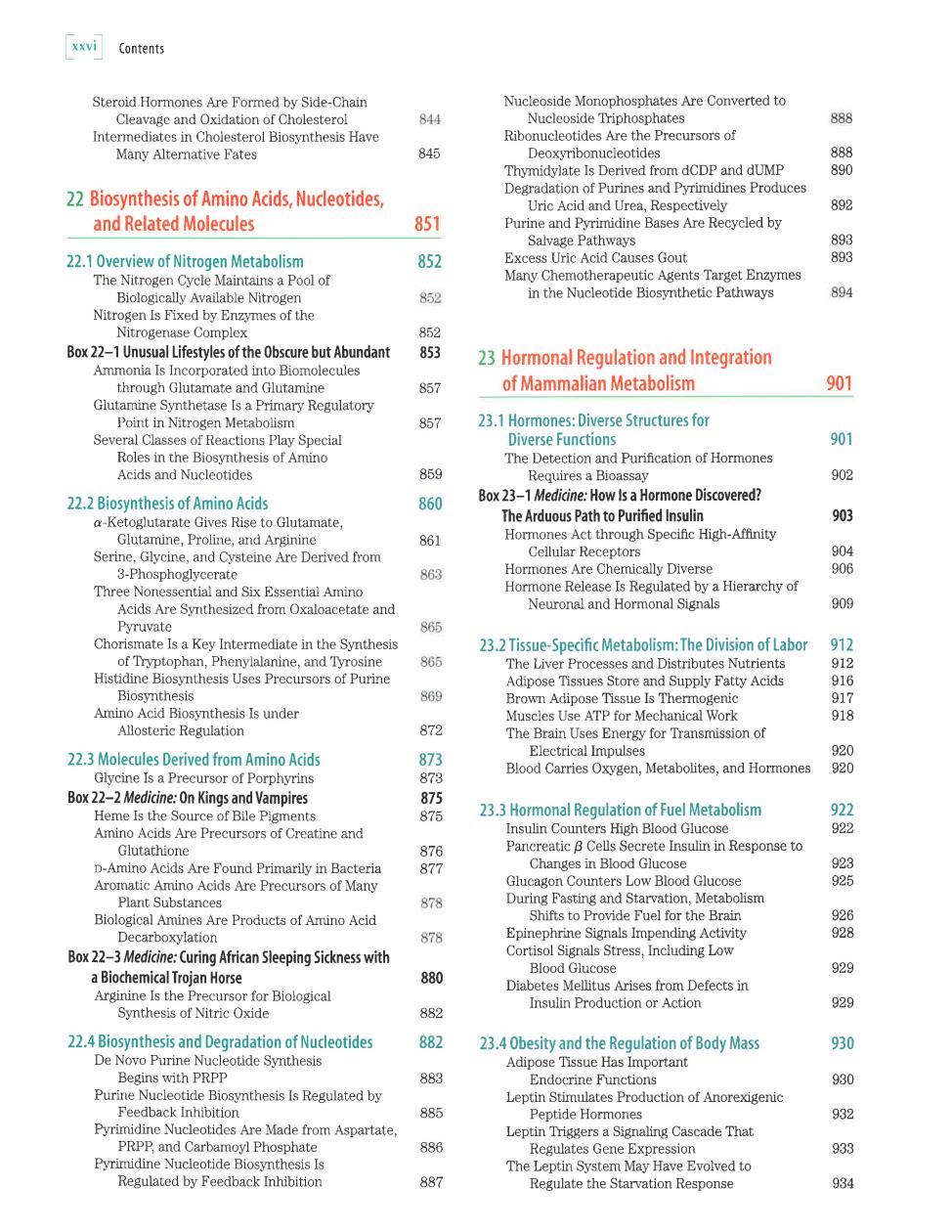
xxviContentsNucleoside Monophosphates Are Converted toSteroid Hormones Are Formed by Side-Chain888844NucleosideTriphosphatesCleavageand Oxidation of CholesterolRibonucleotides Are the Precursors ofIntermediates in Choiesterol Biosynthesis Have888845DeoxyribonucleotidesMany Alternative Fates890Thymidylate Is Derived from dCDP and dUMPDegradation of Purines and Pyrimidines Produces22BiosynthesisofAminoAcids,Nucleotides892Uric Acid and Urea, Respectively851Purine and Pyrimidine Bases Are Recycled byand Related Molecules893SalvagePathways893852ExcessUricAcidCausesGout22.1Overview of Nitrogen MetabolismManyChemotherapeutic Agents TargetEnzymesThe Nitrogen Cycle Maintains a Poolof894in the Nucleotide Biosynthetic Pathways852Biologically Available NitrogenNitrogen Is Fixed by Enzymes of the852Nitrogenase Complex853Box22-1Unusual LifestylesoftheObscurebut Abundant23 Hormonal Regulation and IntegrationAmmonia Is Incorporated into Biomolecules901ofMammalianMetabolism857through Glutamate and GlutamineGlutamine Synthetase Is a Primary Regulatory23.1Hormones:Diverse StructuresforPoint in Nitrogen Metabolism857901Diverse FunctionsSeveral Classes of Reactions Play SpecialRoles in theBiosynthesis of AminoThe Detection and Purification of Hormones859902Acids and NucleotidesRequires a BioassayBox 23-1 Medicine:How Is a Hormone Discovered?22.2Biosynthesis of Amino Acids860903TheArduous Path to Purified Insulinα-Ketoglutarate Gives Rise to Glutamate,Hormones Act through Specific High-Affinity861Glutamine,Proline,and Arginine904CellularReceptorsSerine,Glycine,and Cysteine AreDerived from906Hormones Are ChemicallyDiverse8633-PhosphoglycerateHormoneReleaseIsRegulatedbyaHierarchyofThreeNonessentialandSixEssentialAnino909NeuronalandHormonalSignalsAcidsAreSynthesizedfromOxaloacetateandPyruvate865Chorismate Is a Key Intermediate in the Synthesis91223.2Tissue-SpecificMetabolism:TheDivisionofLabor865of Tryptophan,Phenylalanine,and Tyrosine912TheLiverProcessesandDistributesNutrientsHistidineBiosynthesis Uses Precursors of Purine916AdiposeTissues Store and SupplyFatty Acids869Biosynthesis917Brown Adipose Tissue Is ThermogenicAmino Acid Biosynthesis Is under918Muscles Use ATPfor Mechanical Work872Allosteric RegulationTheBrain Uses Energy for Transmission of920Electrical Impulses87322.3MoleculesDerived fromAminoAcids920Blood Carries Oxygen, Metabolites, and Hormones873Glycine Is a Precursor of Porphyrins875Box22-2Medicine:On Kings and Vampires92223.3Hormonal Regulation ofFuel MetabolismHeme Is the Source of Bile Pigments875922Insulin Counters HighBlood GlucoseAmino Acids Are Precursors of Creatine andPancreaticβ Cells SecreteInsulin in Response to876Glutathione923Changes in Blood GlucoseD-Amino Acids Are Found Primarily in Bacteria877925Glucagon Counters LowBlood GlucoseAromatic AminoAcids Are Precursors of ManyDuring Fasting and Starvation,Metabolism878PlantSubstances926Shifts to Provide Fuel for the BrainBiological Amines Are Products of Amino Acid928Epinephrine Signals Impending ActivityDecarboxylation878Cortisol Signals Stress, Including LowBox 22-3Medicine:Curing African Sleeping Sickness with929Blood Glucose880a Biochemical Trojan HorseDiabetes Mellitus Arises from Defects inArginine Is the Precursor for Biological929Insulin Production or Action882Synthesis of Nitric Oxide88222.4 Biosynthesis and Degradation of Nucleotides93023.4 Obesity and the Regulation of Body MassDe Novo Purine Nucleotide SynthesisAdipose Tissue Has ImportantBeginswithPRPP883930Endocrine FunctionsPurine Nucleotide Biosynthesis Is Regulated byLeptin Stinulates Production of AnorexigenicFeedback Inhibition885932Peptide HormonesPyrimidine Nucleotides Are Made from Aspartate,Leptin Triggers a Signaling Cascade ThatPRPP,andCarbamoylPhosphate886933Regulates Gene ExpressionPyrimidine Nucleotide Biosynthesis IsThe Leptin System May Have Evolved toRegulated byFeedback Inhibition887934Regulate the Starvation Response
T J I xxvr ] Contents Steroid Hormones Are Formed by Side-Chain Cleavage and Oxidation of Cholesterol Intermediates in Cholesterol Bioslmthesis Have Many Alternative Fates 22 Biosynthesis of Amino Acids, Nucleotides, and Related Molecules 22.1 Overview of Nitrogen Metabolism The Nitrogen Cycle Maintains a Pool of Biologically Available Nitrogen Nitrogen ls Fixed by Enzyrnes of the Nitrogenase Complex Box 22-1 Unusual Lifestyles ofthe 0bscure but Abundant Ammonia Is Incorporated hto Biomolecules through Glutamate and Glutamine Glutamine Synthetase Is a Primary Regulatory Point in Nitrogen Metabolism Several Classes of Reactions Play Special Roles in the Biosyrrthesis of Amino Acids and Nucleotides 22.2 Biosynthesis of Amino Acids a-Ketoglutarate Gives Rise to Glutamate, Glrrt:minp Prolinc rnd Aroinine Serine, Glycine, and Cysteine Are Derived from 3-Ph osnh oslveerat e Three Nonessential and Six Essential Amino Acids Are Slnthesized from Oxaloacetate and Py'ruvate Chorismate Is a Key Intermediate in the Synthesis of Tf5.ptophan, Phenylalanine, and T!'rosine Histidine Biosy'nthesis Uses Precursors of Purine Biosl'nthesis Amino Acid Biosy'nthesis Is under Allosteric Regulation 22.3 Molecules Derived from Amino Acids Glycine Is a Precursor of Porphytins Box22-2 Medicine;0n Kings and Vampires Heme Is the Source of Bile Pigments Amino Acids Are Precursors of Creatine and Glutathione o-Amino Acids Are Found Primarily in Bacteria Aromatic Amino Acids Are Precursors of Manv Plant Substances Biological Amines Are Products of Amino Acid Decarboxylation Box22-3 Medicine; Curing African Sleeping Sicknes with a Biochemical Trojan Horse Arginine Is the Precursor for Biological S1'nthesis of Nitric Oxide 22.4 Biosynthesis and Degradation of Nucleotides De Novo Purine Nucleotide Synthesis Begins with PRPP Purine Nucleotide Bios5,'nthesis IRegulated by Feedback Inhibition Pyrimidhe Nucleotides Are Made from Aspartate, PRPP, and Carbamoyl Phosphate Pytimidine Nucleotide Biosynthesis Is Regulated by Feedback Inhibition 845 851 Nucleoside Monophosphates Are Converted to Nucleoside Tfiphosphates Ribonucleotides Are the Precursors of Deoxyribonucleotides Thymidylate Is Derived from dCDP and dUMP Degradation of Purines and Pyrimidines Produces Uric Acid and Urea, Respectively Purine and Py'rimidine Bases Are Recycled by Salvage Pathways Excess Uric Acid Causes Gout Many Chemotherapeutic Agents Target Enz;nnes in the Nucleotide Biosynthetic Pathways 23 Hormonal Regulation ad Integration 857 of Mammalian Metabolism 857 23.1 Hormones: Diverse Structures for Diverse Functions 901 The Detection and Purification of Hormones Requires a Bioassay 902 Box 23-1 Medicine: How ls a Hormone Discovered? TheArduous Pathto Purified Insulin 903 Hormones Act through Speciflc High-Affinity Cellular Receptors 904 Hormones Are Chemically Diverse 906 Hormone Release Is Regulated by a Hierarchy of Neuronal and Hormonal Signals 909 23.2 Tissue-5pecific Metabolism:The Division ofLabor The Liver Processes and Distributes Nutrients Adipose Tissues Store and Supply Fatty Acids Brown Adipose Tissue Is Thermogenic Muscles Use ATP for Mechanical Work The Brain Uses Energy for Ttansmission of Electrical Impulses Blood Carries Oxygen, Metabolites, and Hormones 23.3 Hormonal Regulation of Fuel Metabolism Insulin Counters High Blood Glucose Pancreatic B Cells Secrete Insulin in Response to Changes in Blood Glucose Glucagon Counters Low Blood Glucose During Fasting and Starvation, Metabolism Shifts to Provide Fuel for the Brain Epinephrine Signals Impending Activity Cortisol Signals Stress, Inciuding Low Blood Glucose Diabetes Mellitus Arises from Defects in Insulin Production or Action 23.4 Obesity and the Regulation of Body Mass 930 Adipose Tissue Has Important Endocrine Functions 930 Leptin Stimulates Production of Anorexigenic Peptide Hormones 932 Leptin T?iggers a Signaling Cascade That Regulates Gene Expression 933 The Leptin System May Have Evolved to Regulate the Starvation Response 934 888 890 852 892 893 893 852 853 859 860 901 861 912 912 916 917 918 920 920 922 922 923 925 926 928 929 o90 872 873 873 875 875 876 877 880 882 882 883 885 886 887
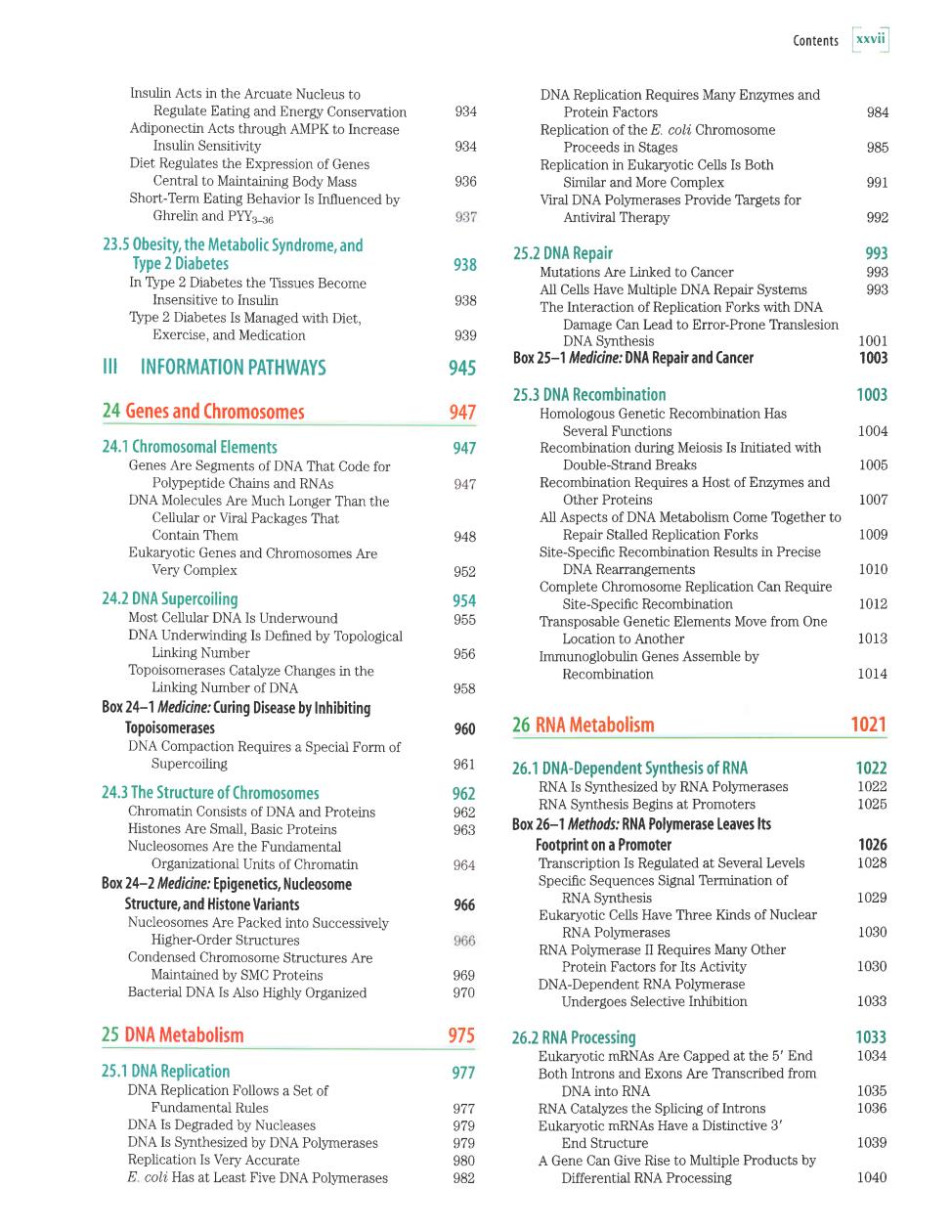
xxviiContentsInsulin Acts in the Arcuate Nucleus toDNA Replication Requires Many Enzymes and934Regulate Eating and Energy Conservation984ProteinFactorsAdiponectin Acts through AMPK to IncreaseReplicationof theE.coli Chromosome934Insulin SensitivityProceeds in Stages985Diet Regulates the Expression of GenesReplication inEukaryotic Cells Is Both936Central to Maintaining Body Mass991Similarand MoreComplexShort-Term Eating Behavior Is Influenced byViral DNA Polymerases Provide Targets forGhrelin and PYY3-36937992Antiviral Therapy23.5Obesity,theMetabolicSyndrome,and99325.2DNA Repair938Type2Diabetes993Mutations Are Linked to CancerIn Type 2 Diabetes the Tissues Become993All Cells Have MultipleDNARepair Systems938InsensitivetoInsulinThe Interaction of Replication Forks withDNAType 2 Diabetes Is Managed with Diet,Damage Can Lead to Error-Prone Translesion939Exercise,and MedicationDNA Synthesis1001Box25-1Medicine:DNA Repair and Cancer1003川945INFORMATIONPATHWAYS100325.3DNA Recombination94724Genesand ChromosomesHomologous Genetic Recombination Has1004Several Functions24.1ChromosomalElements947Recombination during Meiosis Is Initiated withDouble-Strand Breaks1005Genes AreSegments of DNAThat CodeforPolypeptide Chains and RNAs947Recombination Requires a Host of Enzymes and1007DNAMolecules Are Much Longer Than theOtherProteinsCellular or Viral Packages ThatAll Aspects of DNAMetabolismComeTogetherto1009Contain Them948RepairStalledReplicationForksEukaryotic Genes and Chromosomes AreSite-Specific Recombination Results in Precise1010VeryComplexDNA Rearrangements952Complete ChromosomeReplication Can Require24.2 DNA Supercoiling9541012Site-Specific RecombinationMost CellularDNA Is Underwound955TransposabieGeneticElementsMovefromOneDNA Underwinding Is Defined by Topological1013Location to AnotherLinking Number956Immunoglobulin GenesAssemblebyTopoisornerases Catalyze Changes in the1014RecombinationLinking Nurnber of DNA958Box 24-1 Medicine:Curing Disease by Inhibiting102126RNAMetabolism960TopoisomerasesDNACompaction Requiresa SpecialForm of961Supercoiling102226.1DNA-DependentSynthesisof RNA1022RNA Is Synthesized by RNAPolymerases96224.3TheStructureof Chromosomes1025RNA Synthesis Beginsat Promoters962Chromatin Consists of DNA and ProteinsBox26-1Methods:RNAPolymeraseLeavesItsHistones Are Small, Basic Proteins9631026Footprintona PromoterNucleosomes AretheFundamental1028964Transcription Is Regulated at Several LevelsOrganizational Unitsof ChromatinSpecific Sequences Signal Termination ofBox24-2Medicine:Epigenetics,Nucleosome1029RNA Synthesis966Structure,and Histone VariantsEukaryotic Cells Have Three Kinds of NuclearNucleosomes Are Packed into Successively1030RNAPolymerases966Higher-Order StructuresRNAPolymerase II Requires Many OtherCondensed Chromosome Structures Are1030Protein Factors for Its ActivityMaintained by SMCProteins969DNA-Dependent RNAPolymerase970Bacterial DNA Is Also Highly Organized1033Undergoes Selective Inhibition97525DNA Metabolism103326.2RNA ProcessingEukaryotic mRNAs AreCappedat the5'End103425.1DNA Replication977BothIntronsand Exons AreTranscribedfromDNA Replication Follows a Set of1035DNA into RNA1036Fundamental Rules977RNA Catalyzes the Splicing of IntronsDNA Is Degraded by Nucleases979Eukaryotic mRNAs Have a Distinctive3°DNA Is Synthesized byDNAPolymerases1039979EndStructure980Replication Is Very AccurateAGene Can Give Riseto Multiple Products by9821040E.coliHasat LeastFiveDNAPolymerasesDifferential RNA Processing
Insulin Acts in the Arcuate Nucleus to Regulate Eating and Energy Conservation Adiponectin Acts through AMPK to Increase Insulin Sensitivity Diet Regulates the Expression of Genes Central to Maintaining Body Mass Short-Term Eating Behavior Is Influenced by Ghrelin and PYY3_36 23.5 Obesity,he Metabolic Syndrome, and Type 2Diabetes In Tlpe 2 Diabetes the Tissues Become Insensitive to Insulin Dpe 2 Diabetes Is Managed with Diet, Exercise, and Medication III INFORMATION PATHWAYS 24 Genes and Chromosomes Contents l*uii DNA Replication Requires Many Enz5.'rnes and Protein Factors 984 Replication of the E cola Chromosome Proceeds in Stages 985 Replication in Eukaryotic Cells Is Both Similar and More Complex 991 Viral DNA Pol].'rnerases Provide Targets for Antiviral Therapy 992 25.2 DNA Repair 993 Mutations Are Linked to Cancer 993 All Cells Have Multiple DNA Repair Systems 993 The Interaction of Replication Forks with DNA Damage Can Lead to Error-Prone Tlanslesion 934 934 936 938 24.1 Chromosomal Elements Genes Are Segments of DNA That Code for Polypeptide Chains and RNAs DNA Molecules Are Much Longer Than the Cellular or Viral Packages That Contain Them Eukaryotic Genes and Chromosomes Are Very Compiex 24.2 DNA Supercoiling Most Cellular DNA Is Underwound DNA Underwinding Is Defined by Topological Linking Number Topoisomerases Catalyze Changes in the Linking Number of DNA Box 24-1 Medicine: Curing Disease byInhibiting Topoisomerases DNA Compaction Requires a Special Form of Supercoiling 24.3 The Structure of Chromosomes Chromatin Consists of DNA and Proteins Histones Are Small, Basic Proteins Nucleosomes Are the Fundamental Organizational Units of Chromatin Box 24-2 Medicine: Epigenetics, Nucleosome Structure, and Histone Variants Nucleosomes Are Packed into Successively Higher-Order Structures Condensed Chromosome Structures Are Maintained by SMC Proteins Bacterial DNA Is Also Highly Organized 25 DNA Metabolism DNA Slnthesis Box 25-1 Medicine:DNA Repair and Cancer 25.3 DNA Recombination Homologous Genetic Recombination Has Several Functions Location to Another Immunoglobulin Genes Assemble by Recombination 26 RNA Metabolism Recombination during Meiosis Is Initiated with Double-Strand Breaks 1005 Recombination Requires a Host of Enz;.rnes and Other Proteins 1007 A-ll Aspects of DNA Metabolism Come Together to Repair Stalled Replication Forks 1009 Site-Speci-flc Recombination Results in Precise DNA Rearrangements 1010 Complete Chromosome Replication Can Require Site-Specific Recombination 10i2 Tlansoosable Genetic Elements Move from One 938 939 945 947 1001 1003 1003 1004 i0r3 1014 1021 947 947 948 oKt 954 vDo 958 960 961 962 962 963 964 966 oAq 970 26.1 DNA-Dependent Synthesis of RNA RNA Is Sy'nthesized by RNA Poll.rnerases RNA Synthesis Begins at Promoters Box 26-1 Methods: RNA Polymerase Leaves lt Footprint ona Promoter Tlanscription Is Regulated at Several Levels Speci-flc Sequences Signal Termination of RNA Synthesis 1022 r022 r025 1026 1028 r029 25.1 DNA Replication DNA Replication Follows a Set of Fundamental Rules DNA Is Degraded by Nucleases DNA Is SS,rrthesized by DNA Pol].rynerases Replication Is Very Accurate E coli, Has at Least Five DNA Polrrmerases Eukaryotic Cells Have Three Kinds of Nuclear RNA Polymerases 1030 RNA Pol].rynerase II Requires Many Other Protein Factors for lts Activity DNA-Dependent RNA Pol3.'rnerase Undergoes Selective Inhibition 26.2 RNA Processing Eukaryotic mRNAs Are Capped at the 5' End Both Introns and Exons Are Ttanscribed from DNAinto RNA RNA Catalyzes the Splicing of Introns Eukaryotic mRNAs Have a Distinctive 3' End Structure A Gene Can Give Rise to Multiple Products by Differential RNA Processinq 975 1030 1033 1033 1034 1035 1036 1039 1040 977 977 o70 979 980 982
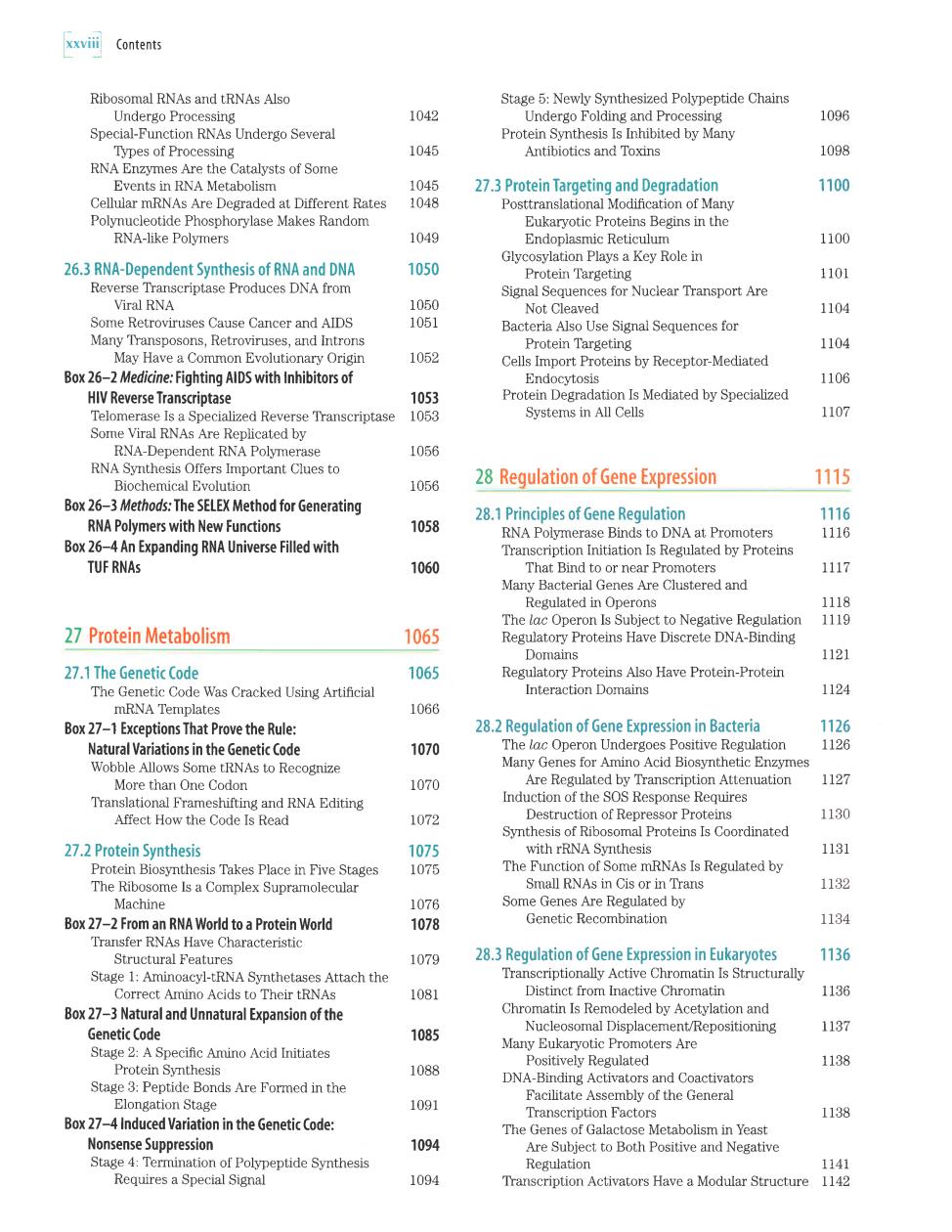
xxviliContentsRibosomal RNAs and tRNAs AlsoStage 5: Newly Synthesized Polypeptide Chains10421096Undergo ProcessingUndergoFolding and ProcessingSpecial-Function RNAs Undergo SeveralProtein Synthesis Is Inhibited by Many10451098Types of ProcessingAntibiotics and ToxinsRNA Enzymes Are the Catalysts of Some1100104527.3Protein TargetingandDegradationEvents in RNA Metabolism1048Cellular mRNAs Are Degraded at Different RatesPosttranslational Modification of ManyPolynucleotidePhosphorylaseMakes RandomEukaryotic Proteins Begins in the1049RNA-like Polymers1100EndoplasmicReticulumGlycosylation Plays a Key Role in105026.3 RNA-Dependent Synthesis of RNA and DNA1101Protein TargetingReverse TranscriptaseProduces DNAfromSignal Sequences for Nuclear Transport AreViral RNA10501104Not Cleaved1051Some Retroviruses Cause Cancer and AIDSBacteria Also Use Signal Sequences forMany Transposons, Retroviruses, and Introns1104Protein Targeting1052May Have a Common Evolutionary OriginCells Import Proteins by Receptor-MediatedBox26-2Medicine:FightingAIDSwithInhibitorsof1106EndocytosisProtein Degradation Is Mediated by Specialized1053HIVReverseTranscriptase1107Systems in All CellsTelomerase Is a Specialized Reverse Transcriptase1053Some Viral RNAs Are Replicated by1056RNA-Dependent RNA PolymeraseRNA Synthesis Offers Important Clues to111528 Regulation of Gene Expression1056Biochemical EvolutionBox 26-3Methods:The SELEX Method forGenerating111628.1 Principles of Gene RegulationRNA Polymerswith NewFunctions10581116RNAPolymerase Binds to DNA at PromotersBox26-4AnExpandingRNAUniverseFilledwithTranscription Initiation IsRegulated by ProteinsTUF RNAS10601117ThatBind to ornear PromotersMany Bacterial Genes Are Clustered and1118Regulated in Operons1119The lac Operon Is Subject to Negative Regulation27Protein Metabolism1065RegulatoryProteins HaveDiscreteDNA-Binding1121Domains1065Regulatory Proteins Also Have Protein-Protein27.1TheGeneticCode1124Interaction DomainsThe Genetic Code Was Cracked Using Artificial1066mRNA Templates112628.2Regulationof GeneExpressionin BacteriaBox27-1ExceptionsThat ProvetheRule:1126The lac Operon Undergoes Positive Regulation1070Natural Variations in theGenetic CodeMany Genes for Amino Acid Biosynthetic EnzymesWobbleAllows SometRNAstoRecognize1127Are Regulatedby Transcription Attenuation1070More than One CodonInductionof theSOSResponseRequiresTranslational Frameshifting and RNA Editing1130Destruction of RepressorProteins1072AffectHowthe CodeIs ReadSynthesis of Ribosomal Proteins Is Coordinated1131with rRNA Synthesis27.2Protein Synthesis1075TheFunction of SomemRNAs Is RegulatedbyProteinBiosynthesis Takes Place in Five Stages10751132Small RNAs in Cis or inTransThe Ribosome Is a Complex SupramolecularSome Genes Are Regulated by1076Machine1134Genetic Recombination1078Box27-2Froman RNAWorldtoaProtein WorldTransfer RNAs Have Characteristic113628.3 Regulation of Gene Expression in EukaryotesStructural Features1079Transcriptionally Active Chromatin Is StructurallyStage 1:Aminoacyl-tRNA Synthetases Attach the1136DistinctfromInactive Chromatin1081Correct Amino Acids to Their tRNAsChromatin Is Remodeled by Acetylation andBox27-3Natural and Unnatural Expansion of the1137NucleosomalDisplacement/RepositioningGeneticCode1085Many Eukaryotic Promoters AreStage 2: A Specific Amino Acid InitiatesPositively Regulated11381088Protein SynthesisDNA-Binding Activators and CoactivatorsStage3:Peptide Bonds AreFormed in theFacilitate Assembly of the General1091Elongation Stage1138Transcription FactorsBox 27-4 Induced Variation in the Genetic Code:The Genes of Galactose Metabolism in Yeast1094Nonsense SuppressionAre Subject to Both Positive and NegativeStage 4: Termination of Polypeptide Synthesis1141RegulationRequires a Special Signal1094Transcription Activators Have a Modular Structure1142
f- .J lxxvlil Co nte nts Ribosomal RNAs and tRNAs Also Undergo Processing Special-Function RNAs Undergo Several T\meq nf Prnnocc - -,m9 RNA Enz5rmes Are the Catalysts of Some Events in RNA Metabolism Cellu-lar mRNAs Are Degraded at Different Rates Polynucleotide Phosphorylase Makes Random RNAlike Polynners 26.3 RNA-Dependent Syhesis ofRNA and DNA Reverse Ttanscriptase Produces DNA from Viral RNA Some Retroviruses Cause Cancer and AIDS Many Tlansposons, Retroviruses, and Introns May Have a Common Evolutionary Origin Box26-2 Medicinej Fighting AlD5 with Inhibitors of HIV Reverse Transcriptase Telomerase Is a Specialized Reverse Tlanscriptase Some Viral RNAs Are Replicated by RNA-Dependent RNA Pol}.'rnerase RNA Synthesis Offers Important Clues to Biochemical Evolution Box26-3 Methods: The SEIEX Method for Generating RNA Polymers with New Functions Box 26-4 An Expanding RNA Universe Filled with TUF RNAs 27 Protein Metabolism 27.1 The Genetic (ode The Genetic Code Was Cracked Using Arti-flcial mRNA Templates Box27-'l Exceptions That Prove the Rule: Natural Variations i the Genetic Code Wobble Allows Some tRNAs to Recognize More than One Codon Tlanslational Frameshifting and RNA Editing A-ffect How the Code Is Read 27.2 Protein Synthesis Protein Biosy'nthesis Takes Place in Five Stages The Ribosome Is a Complex Supramolecular Machine Box27-2 From an RNA World to a Protein World Ttansfer RNAs Have Characteristic Structural Features Stage 1: Aminoacyl-tRNA S1'nthetases Attach the Correct Amino Acids to Their tRNAs Box 27-3 Natural and Unnatural Expansion ofthe Genetic Code Stage 2: A Speci-flc Amino Acid Initiates Protein Synthesis Stage 3: Peptide Bonds Are Formed in the Elongation Stage Box27-4 Induced Variation in the Genetic (ode: Nonsense Suppression Stage 4: Termination of Polypeptide Synthesis Requires a Special Signal Stage 5: Newly Synthesized Pollpeptide Chains Undergo Folding and Processing Protein S;,nthesis Is Inhibited by Many Antibiotics and Toxins 27.3 Protein Targeting and Degradation Posttranslational Modi-flcation of Many Eukaryotic Proteins Begins in the Endopiasmic Reticulum Glycosylation Plays a Key Role in Prnlpin Trrdptind Signal Sequences for Nuclear Ttansport Are Not Cleaved Bacteria Also Use Signal Sequences for Protein Targeting Cells Import Proteins by Receptor-Mediated Endocytosis Small RNAs in Cis or in Ttans Some Genes Are Regulated by Genetic Recombination Positively Regulated DNA-Binding Activators and Coactivators Facilitate Assembly of the General Transcriotion Factors Protein Degradation Is Mediated by Specialized Svstems in All Cells Il07 28 Regulationf Gene Expression 1115 28.1 Principles of Gene Regulation 1116 RNA Poil'rnerase Binds to DNA at Promoters 1116 Ttanscription Initiation Is Regulated by Proteins That Bind to or near Promoters IIIT Many Bacterial Genes Are Clustered and Regulated in Operons 1 1 18 The Lac Operon Is Subject to Negative Regulation 1119 Regulatory Proteins Have Discrete DNA-Binding Domains IfzI Regulatory Proteins Also Have Protein-Protein Interaction Domains II24 28.2 Regulation of Gene Expression in Bacteria 1126 The lac Operon Undergoes Positive Regu-lation 11.26 Many Genes for Amino Acid Biosynthetic Enzlmes Are Regulated by Ttanscription Attenuation 1127 lnduction of the SOS Response Requires Destruction of Repressor Proteins S]'nthesis of Ribosomal Proteins Is Coordinated with rRNA Synthesis 1131 The Function of Some mRNAs Is Regulated by r042 1045 1045 1048 1049 1 050 1050 1051 t052 1 053 1053 1056 1056 1058 1060 1065 1096 1098 1100 1 100 1101 1104 1104 1106 1 065 1066 1070 1070 r072 1 075 1075 r076 1078 1079 1081 1085 1088 1091 1094 r094 28.3 Regulation ofGene Expression in Eukaryotes 1136 Ttanscriptionally Active Chromatin Is Structurally Distinct from Inactive Chromatin 1136 Chromatin Is Remodeled by Acetylation and NucleosomalDisplacement/Repositioning 1137 Many Eukaryotic Promoters Are 1 130 II32 I134 1 138 I 138 The Genes of Galactose Metabolism in Yeast Are Subject to Both Positive and Negative Regulation 1141 Tfanscription Activators Have a Modular Structure lI42
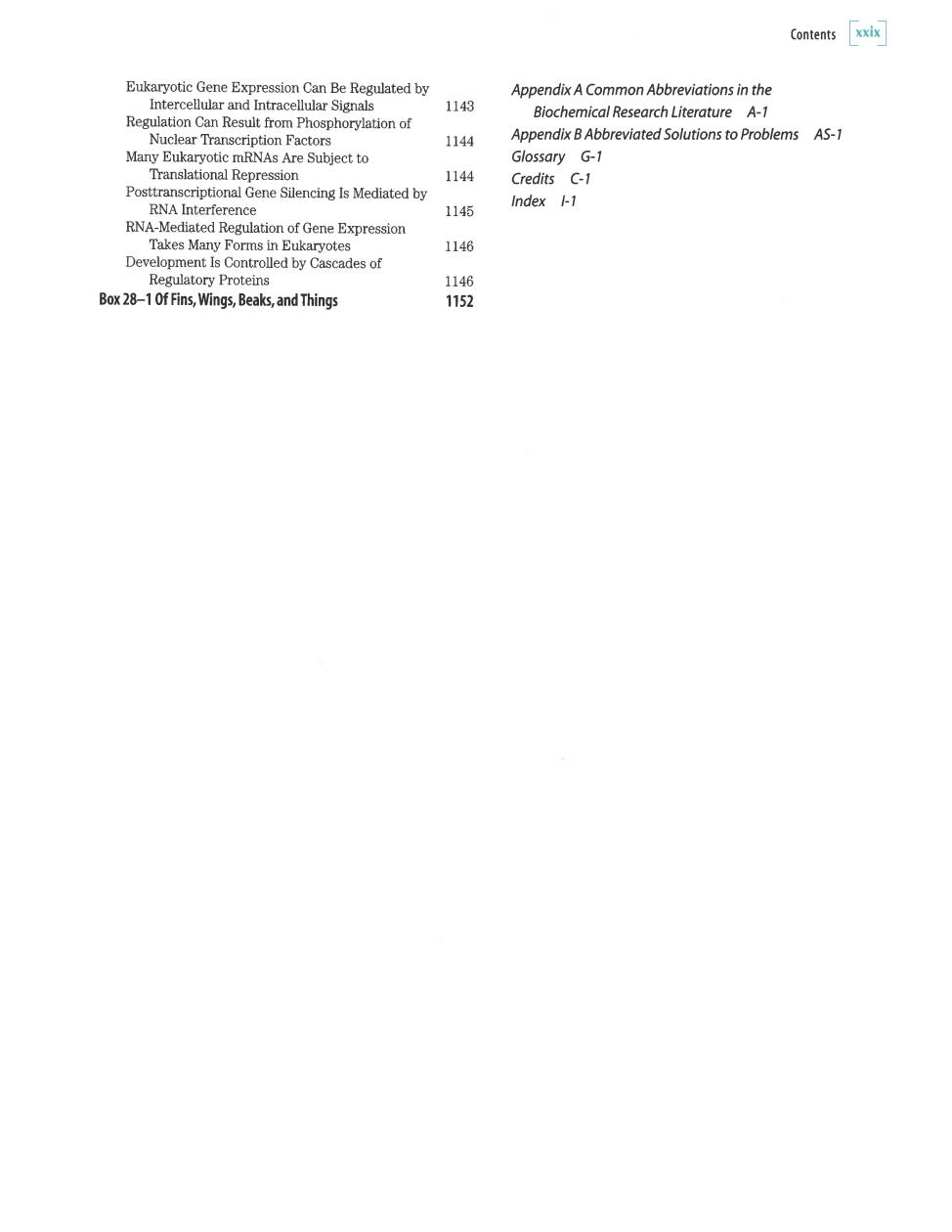
xxixContentsEukaryotic Gene Expression Can Be Regulated byAppendixACommonAbbreviations in theIntercellular and Intracellular Signals1143BiochemicalResearchLiteratureA-1Regulation CanResultfromPhosphorylationofAppendixBAbbreviatedSolutionstoProblemsAS-1Nuclear Transcription Factors1144Many Eukaryotic mRNAs Are Subject toGlossaryG-1Translational Repression1144CreditsC-1Posttranscriptional Gene Silencing Is Mediated byIndexI-1RNAInterference1145RNA-Mediated Regulation of Gene ExpressionTakes ManyForms inEukaryotes1146Development Is Controlled by Cascades ofRegulatoryProteins1146Box 281fFins,Wings,Beaks,andThing1152
Contents I xxix I Eukaryotic Gene Expression Can Be Regulated by Appendix ACommon Abbreviations in the Intercellular and Intracellular Signals 1143 Biochemical Research Literature A_l Regulation Can Result from Phosphorylation of Nuclear Tlanscription Factors rl44 Appendix B Abbreviated solutions to Problems As-l Many Eukaryotic mRNAs Are Subject to Glossary G-| Tlanslational Repression LI44 Credits C-l Posttranscriptional Gene Silencing Is Mediaterl hrz RNA Interference 'v vr 1145 Index l-1 RNA-Mediated Regulation of Gene Expression Takes Many Forms in Eukaryotes 1146 Development Is Controlled by Cascades of Regulatory Proteins 1146 Box28-1 0fFins,Wings,Beaks,andThings 1152